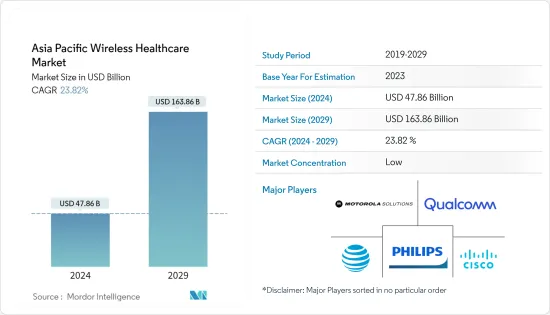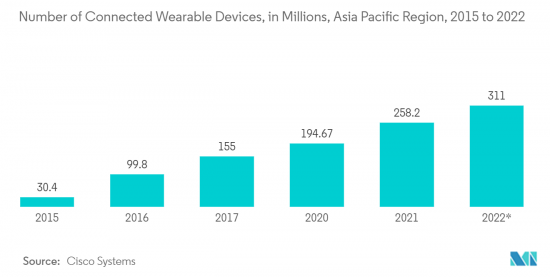PUBLISHER: Mordor Intelligence | PRODUCT CODE: 1403140

PUBLISHER: Mordor Intelligence | PRODUCT CODE: 1403140
Asia Pacific Wireless Healthcare - Market Share Analysis, Industry Trends & Statistics, Growth Forecasts 2024 - 2029

The Asia Pacific Wireless Healthcare Market size is estimated at USD 47.86 billion in 2024, and is expected to reach USD 163.86 billion by 2029, growing at a CAGR of 23.82% during the forecast period (2024-2029).
The Asia Pacific wireless healthcare market is significantly driven by growing digitization, increased use of connected devices, advancements in wireless technology, and rising adoption of patient-centric approaches by healthcare organizations coupled with increasing demand for quality healthcare.
Key Highlights
- Wireless devices and sensors enable remote monitoring of patient's vital signs and health conditions. This allows healthcare providers to track patients' health status in real-time and intervene when necessary. Wireless communication facilitates telemedicine services, allowing patients to consult with healthcare professionals remotely via video, voice, or messaging. This is especially valuable for individuals in remote areas or those with limited mobility.
- The emergence of Wearable Devices is driving the market. Owing to the proliferation of smartphones and the acceptance of wearable devices, medical devices, and diagnostic centers are experimenting with body-worn sensors that can monitor vital signs and transmit them in real time to an online platform that can be remotely accessed.
- Advancements in wireless communication technology have played a pivotal role in driving the growth and evolution of the wireless healthcare market. These technological innovations have enabled the development of new and more effective healthcare solutions, transforming the healthcare is delivered, monitored, and managed.
- Resistance from traditional healthcare providers restrains the growth of the wireless healthcare market. Traditional healthcare providers may need more familiarity with wireless technologies and the necessary training to implement and use them effectively. The healthcare sector places a high emphasis on patient safety and data security.
- Governments and healthcare systems in the Asia Pacific region promoted the use of digital health solutions to manage the COVID-19 pandemic. This included contact tracing apps, health monitoring apps, and others. Wireless technologies could aid in tracking and managing the spread of the virus.
- Post-COVID-19 pandemic, patients increased familiarity with telemedicine and wearable devices could lead to a greater focus on patient engagement and self-management. Wireless healthcare technologies can empower individuals to take more control of their health.
Asia Pacific Wireless Healthcare Market Trends
Home Care Application Segment is Expected to Hold Significant Market Share
- Wireless sensors and wearable devices enable healthcare providers to remotely monitor patients' vital signs, health conditions, and medication adherence. This real-time data helps healthcare make real decisions and intervene promptly when necessary.
- According to Cisco Systems, The Wearables used in the Asia Pacific region is 311 million devices in 2022. Wearables used in North America and Asia Pacific are forecasted to account for around 70 percent of the wearable 5G connections globally in 2022.
- Home care applications enable patients to have virtual consultations with healthcare providers through video calls or other communication platforms. This is useful for follow-up appointments, routine check-ups, and non-emergency medical concerns.
- Patients with chronic conditions can benefit from home care applications that offer personalized care plans, medication reminders, and continuous monitoring. These applications empower patients to actively manage their health while staying connected to their healthcare providers.
- The adoption of home care applications in the Asia Pacific wireless healthcare market is likely to continue growing, driven by factors such as the need for remote healthcare services, advancements in wireless technology, changing healthcare delivery models, and the emphasis on patient-centered care.

China is Expected to Hold Significant Market Share
- China has actively promoted digital health initiatives as part of its healthcare reform efforts. The Chinese government has recognized the potential of wireless technologies to enhance healthcare accessibility, quality, and efficiency.
- Telemedicine has gained traction in China, specifically in remote and rural areas where access to healthcare services can be challenging. Wireless communication technologies have enabled virtual consultations, diagnostics, and follow-up care through platforms connecting patients and healthcare providers.
- Wireless devices and sensors have been increasingly used for remote patient monitoring in China. These devices allow healthcare providers to track patients' health conditions in real-time and provide timely interventions when necessary.
- The deployment of 5G technology and expansion of 5G base stations have the potential to impact the wireless healthcare market in China significantly. 5G technology offers faster speeds, lower latency, and increased connectivity, enabling various healthcare applications and services that rely on real-time data transmission and communication.
- According to MIIT, By the end of 2022, the number of 5G base stations in China was approximately 2.31 million. With extensive infrastructure investments and ambitious rollout plans, China has achieved significant 5G coverage. According to forecasts, by 2024, the number of base stations was projected to reach about six million.
Asia Pacific Wireless Healthcare Industry Overview
The Asia Pacific wireless healthcare market is highly fragmented due to the presence of major players like AT&T Inc., Cisco Systems Inc., Motorola Solutions Inc., Koninklijke Philips NV, and Qualcomm Technologies Inc. Players in the market are adopting strategies such as partnerships and acquisitions to enhance their product offerings and gain sustainable competitive advantage.
In September 2022, Philips Foundation and RAD-AID International formed a multi-year cross-continental collaboration to increase access to mobile ultrasound services for 50 million people in low- and middle-income countries. The new partnership sets up the intensive program in 10 countries, including countries in Asia, to train various health workers and specialists through real-time distance education and simulated procedure demonstrations. The co-created program aims to reach 50 million people by deploying hundreds of ultrasound devices, allowing remote healthcare thousands of kilometers away.
In September 2022, Verizon Business and Visionable, one of the leading health technology companies, announced that they are expanding their partnership, allowing both companies to work on various connected healthcare solutions in the United States using Visionable's patented technology powered by Verizon's 5G Ultra Wideband and 5G Edge networks. Verizon and Visionable are collaborating on a secure next-generation digital healthcare collaboration platform that will allow healthcare professionals in the APAC and EMEA regions to access data, collaborate, and share resources.
Additional Benefits:
- The market estimate (ME) sheet in Excel format
- 3 months of analyst support
TABLE OF CONTENTS
1 INTRODUCTION
- 1.1 Study Assumptions and Market Definition
- 1.2 Scope of the Study
2 RESEARCH METHODOLOGY
3 EXECUTIVE SUMMARY
4 MARKET INSIGHTS
- 4.1 Market Overview
- 4.2 Industry Value Chain Analysis
- 4.3 Industry Attractiveness - Porter's Five Forces Analysis
- 4.3.1 Bargaining Power of Suppliers
- 4.3.2 Bargaining Power of Consumers
- 4.3.3 Threat of New Entrants
- 4.3.4 Threat of Substitutes
- 4.3.5 Intensity of Competitive Rivalry
- 4.4 Technology Snapshot
- 4.4.1 Wireless Personal Area Network (WPAN)
- 4.4.2 Wi-Fi
- 4.4.3 Worldwide Interoperability for Microwave Access (WiMAX)
- 4.5 Assessment of COVID-19 impact on the Market
5 MARKET DYNAMICS
- 5.1 Market Drivers
- 5.1.1 Advancements in Wireless Communication Technology
- 5.1.2 Emergence of Wearable Devices
- 5.2 Market Restraints
- 5.2.1 Resistance From Traditional Healthcare Providers
6 MARKET SEGMENTATION
- 6.1 By Component
- 6.1.1 Hardware
- 6.1.2 Software
- 6.1.3 Services
- 6.2 By Application
- 6.2.1 Hospitals and Nursing Homes
- 6.2.2 Home Care
- 6.2.3 Pharmaceuticals
- 6.3 By Country
- 6.3.1 China
- 6.3.2 India
- 6.3.3 Japan
- 6.3.4 South Korea
- 6.3.5 Rest of Asia Pacific
7 COMPETITIVE LANDSCAPE
- 7.1 Company Profiles
- 7.1.1 AT&T Inc.
- 7.1.2 Cisco Systems Inc.
- 7.1.3 Motorola Solutions Inc.
- 7.1.4 Koninklijke Philips NV
- 7.1.5 Qualcomm Technologies Inc.
- 7.1.6 Samsung Electronics Co. Ltd
- 7.1.7 Verizon Communications Inc.
- 7.1.8 Apple Inc.
- 7.1.9 Extreme Networks Inc.
- 7.1.10 Allscripts Healthcare Solutions Inc.
8 INVESTMENT ANALYSIS
9 FUTURE OF THE MARKET




